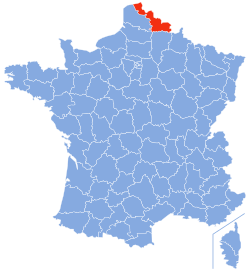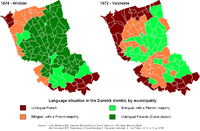Nord (French department)

Multi tool use
Nord | |||
|---|---|---|---|
Department | |||
 Prefecture building of the Nord department, in Lille | |||
| |||
 Location of Nord in France | |||
| Coordinates: 50°23′N 03°19′E / 50.383°N 3.317°E / 50.383; 3.317Coordinates: 50°23′N 03°19′E / 50.383°N 3.317°E / 50.383; 3.317 | |||
| Country | France | ||
| Region | Hauts-de-France | ||
| Prefecture | Lille | ||
| Subprefectures | Avesnes- sur-Helpe Cambrai Douai Dunkirk Valenciennes |
||
| Government | |||
| • President of the General Council |
Patrick Kanner | ||
| Area 1 | |||
| • Total | 5,742.74 km2 (2,217.28 sq mi) | ||
| Population (2016) | |||
| • Total | 2,603,723 | ||
| • Rank | 1st | ||
| • Density | 450/km2 (1,200/sq mi) | ||
| Time zone | UTC+1 (CET) |
||
| • Summer (DST) | UTC+2 (CEST) |
||
| Department number | 59 | ||
| Arrondissements | 6 | ||
| Cantons | 41 | ||
| Communes | 648 | ||
^1 French Land Register data, which exclude estuaries, and lakes, ponds, and glaciers larger than 1 km2 | |||
Nord (French pronunciation: [nɔʁ]; English: North; Dutch: Noorderdepartement) is a department in the far north of France. It was created from the western halves of the historical counties of Flanders and Hainaut, and the Bishopric of Cambrai. The modern coat of arms was inherited from the County of Flanders.
Nord is the country's most populous department. It also contains the metropolitan region of Lille, the fifth-largest urban area in France after Paris, Lyon, Marseille, and Toulouse. Within the department is located the part of France where the French Flemish dialect of Dutch is still spoken (along with French) as a native language.
Contents
1 History
2 Geography
3 Demographics
4 Politics
4.1 Current National Assembly Representatives
5 Economy
6 Tourism
7 See also
8 References
9 External links
History
Tribes of the Belgae, such as the Menapii and Nervii were the first peoples recorded in the area later known as Nord.
During the 4th and 5th Centuries, Roman rulers of Gallia Belgica secured the route from the major port of Bononia (Boulogne) to Colonia (Cologne), by co-opting Germanic peoples north-east of this corridor, such as the Tungri. In effect, the area known later as Nord became an isogloss (linguistic border) between the Germanic and Romance languages. Saxon colonisation of the region from the 5th to the 8th centuries likely shifted the isogloss further south so that, by the 9th century, most people immediately north of Lille spoke a dialect of Old Dutch. This has remained evident in the place names of the region. After the County of Flanders became part of France in the 9th century, the isogloss moved north and east.[1]

Extent of West Flemish spoken in the arrondissement of Dunkirk in 1874 and 1972 respectively.
During the 14th Century, much of the area came under the control of the Duchy of Burgundy and in subsequent centuries was therefore part of the Habsburg Netherlands (from 1482) and the Spanish Netherlands (1581).
Areas that later constituted Nord were ceded to France by treaties in 1659, 1668, and 1678, becoming the Counties of Flanders and Hainaut, and part of the Bishopric of Cambrai.
On 4 March 1790, during the French Revolution, Nord became one of the original 83 departments created to replace the counties.
Modern government policies making French the only official language have led to a decline in use of the Dutch West Flemish dialect. There are currently 20,000 speakers of a sub-dialect of West Flemish in the arrondissement of Dunkirk and it appears likely that this particular sub-dialect will be extinct within decades.[1]There is, however, a movement to bring back use of the Dutch language as a second official language.
Geography
Nord is part of the current Hauts-de-France region and is surrounded by the French departments of Pas-de-Calais and Aisne, as well as by Belgium and the North Sea.
Situated in the north of the country along the western half of the Belgian frontier, the department is unusually long and narrow. Its principal city is Lille, which with nearby Roubaix, Tourcoing and Villeneuve d'Ascq constitutes the center of a cluster of industrial and former mining towns totalling slightly over a million inhabitants. Other important cities are Valenciennes, Douai, and Dunkirk.
The principal rivers are the following: Yser, Lys, Escaut, Scarpe, Sambre
Demographics
Nord is the most heavily populated department, with a population of 2,617,939[2] and an area of 5,743 km².
Politics
The President of the Departmental Council is the unaffiliated right-winger Jean-René Lecerf.
The first President of the Fifth Republic, General Charles de Gaulle, was born in Lille in the department on 22 November 1890.
| Party | seats |
|
|---|---|---|
• |
The Republicans (LR) |
25 |
Socialist Party (PS) |
16 |
|
• |
Miscellaneous right (DVD) |
15 |
• |
Union of Democrats and Independents (UDI) |
11 |
French Communist Party (PCF) |
10 |
|
Miscellaneous left (DVG) |
2 |
|
• |
France Arise (DLF) |
1 |
Citizen and Republican Movement (MRC) |
1 |
|
Radical Party of the Left (PRG) |
1 |
|
Current National Assembly Representatives
| Constituency | Member[3] |
Party |
|
|---|---|---|---|
Nord's 1st constituency |
Adrien Quatennens |
La France Insoumise |
|
Nord's 2nd constituency |
Ugo Bernalicis |
La France Insoumise |
|
Nord's 3rd constituency |
Christophe Di Pompeo |
La République En Marche! |
|
Nord's 4th constituency |
Brigitte Liso |
La République En Marche! |
|
Nord's 5th constituency |
Sébastien Huyghe |
The Republicans |
|
Nord's 6th constituency |
Charlotte Lecocq |
La République En Marche! |
|
Nord's 7th constituency |
Francis Vercamer |
Union of Democrats and Independents |
|
Nord's 8th constituency |
Catherine Osson |
La République En Marche! |
|
Nord's 9th constituency |
Valérie Petit |
La République En Marche! |
|
Nord's 10th constituency |
Vincent Ledoux |
The Republicans |
|
Nord's 11th constituency |
Laurent Pietraszewski |
La République En Marche! |
|
Nord's 12th constituency |
Anne-Laure Cattelot |
La République En Marche! |
|
Nord's 13th constituency |
Christian Hutin |
Citizen and Republican Movement |
|
Nord's 14th constituency |
Paul Christophe |
The Republicans |
|
Nord's 15th constituency |
Jennifer de Temmerman |
La République En Marche! |
|
Nord's 16th constituency |
Alain Bruneel |
French Communist Party |
|
Nord's 17th constituency |
Dimitri Houbron |
La République En Marche! |
|
Nord's 18th constituency |
Guy Bricout |
Union of Democrats and Independents |
|
Nord's 19th constituency |
Sébastien Chenu |
National Rally |
|
Nord's 20th constituency |
Fabien Roussel |
French Communist Party |
|
Nord's 21st constituency |
Béatrice Descamps |
Union of Democrats and Independents |
|
Economy
At the forefront of France's 19th century industrialisation, the area suffered severely during World War I and now faces the economic, social and environmental problems associated with the decline of coal mining with its neighbours following the earlier decline of the Lille-Roubaix textile industry.
Until recently, the department was dominated economically by coal mining, which extended through the heart of the department from neighbouring Artois into central Belgium.
Tourism
The old stock exchange of Lille

Saint-Winoc Abbey in Bergues

Belfry of Douai
Windmill in Boeschepe
Mining museum in Lewarde
See also
- Cantons of the Nord department
- Communes of the Nord department
- Arrondissements of the Nord department (France)
- French Flemish
- Université Lille Nord de France
References
- INSEE
^ ab "Dutch dialect" (PDF)..mw-parser-output cite.citation{font-style:inherit}.mw-parser-output .citation q{quotes:"""""""'""'"}.mw-parser-output .citation .cs1-lock-free a{background:url("//upload.wikimedia.org/wikipedia/commons/thumb/6/65/Lock-green.svg/9px-Lock-green.svg.png")no-repeat;background-position:right .1em center}.mw-parser-output .citation .cs1-lock-limited a,.mw-parser-output .citation .cs1-lock-registration a{background:url("//upload.wikimedia.org/wikipedia/commons/thumb/d/d6/Lock-gray-alt-2.svg/9px-Lock-gray-alt-2.svg.png")no-repeat;background-position:right .1em center}.mw-parser-output .citation .cs1-lock-subscription a{background:url("//upload.wikimedia.org/wikipedia/commons/thumb/a/aa/Lock-red-alt-2.svg/9px-Lock-red-alt-2.svg.png")no-repeat;background-position:right .1em center}.mw-parser-output .cs1-subscription,.mw-parser-output .cs1-registration{color:#555}.mw-parser-output .cs1-subscription span,.mw-parser-output .cs1-registration span{border-bottom:1px dotted;cursor:help}.mw-parser-output .cs1-ws-icon a{background:url("//upload.wikimedia.org/wikipedia/commons/thumb/4/4c/Wikisource-logo.svg/12px-Wikisource-logo.svg.png")no-repeat;background-position:right .1em center}.mw-parser-output code.cs1-code{color:inherit;background:inherit;border:inherit;padding:inherit}.mw-parser-output .cs1-hidden-error{display:none;font-size:100%}.mw-parser-output .cs1-visible-error{font-size:100%}.mw-parser-output .cs1-maint{display:none;color:#33aa33;margin-left:0.3em}.mw-parser-output .cs1-subscription,.mw-parser-output .cs1-registration,.mw-parser-output .cs1-format{font-size:95%}.mw-parser-output .cs1-kern-left,.mw-parser-output .cs1-kern-wl-left{padding-left:0.2em}.mw-parser-output .cs1-kern-right,.mw-parser-output .cs1-kern-wl-right{padding-right:0.2em} (404 KB)
^ Insee 2010.
^ http://www.assemblee-nationale.fr/
External links
(in French) Prefecture website
(in French) General Council website
(in English) Nord (French department) at Curlie
kHQl vq,iT O,JBeg rrUd,g6JjaOrmVV76KU,7Zimkl






